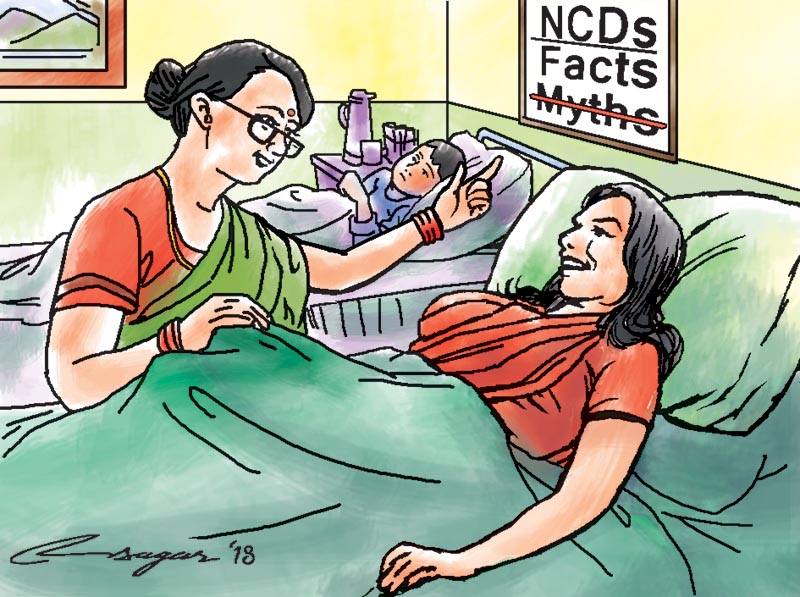Myths about NCDs: Shift in approach required
To shift the approach, health care providers must return ownership and responsibility for health to each person, empowering healthy self-determination and respecting everyone’s intrinsic human dignity
An alarming rise in non-communicable diseases (NCDs) such as obesity, hypertension and diabetes is silently threatening Nepal. According to national data, more than 1 in every 4 persons in Nepal suffer from hypertension, and many don’t even know it. Uncontrolled hypertension and diabetes can cause stroke, blindness, heart disease and kidney failure. The consequences of NCDs are more than just premature death; they are leading causes of disability and compromise development in Nepal.
These are unacceptable, preventable problems, and will continue to increase unless we address some of the commonly held myths about NCDs. The first myth is that people in Nepal and developing countries rarely get NCDs because these are diseases of affluence coming from too much food, salt, sugar and too little exercise. But actually, hypertension is the leading cause of morbidity and mortality around the world. In fact, two-thirds of the global burden of hypertension occurs in countries of the developing world like Nepal.
In Nepal and many developing countries, the importation of “western” lifestyles and products, combined with urban migration, has exposed many people to risks linked to NCDs, even if they haven’t moved up the economic ladder. Moreover, poor nutrition during early life may actually increase a person’s vulnerability to developing NCDs once they adopt lifestyles of more sugar, salt, calories, and less physical activity. The second myth is that all countries follow the same health trajectory: first, a country eliminates or reduces deaths from poverty and then the diseases of affluence such as hypertension and diabetes begin to increase. The history of the disease in the Western countries was indeed sequential. But in places like Nepal, NCDs are adding to, not following the elimination of perinatal mortality, childhood diarrhoeal deaths, malaria, TB and other infectious diseases.
Indeed, there is a diabolical synergy emerging as NCDs have entered the health theatres of developing countries before the curtains have closed on diseases of the poor. Having diabetes actually increases a person’s vulnerability to TB infection, and infected persons with diabetes are more contagious to others. It has also been shown that diabetes interferes with TB treatments. Thus the introduction of NCDs like diabetes before the elimination of diseases of poverty actually undermines the control of infectious diseases.
The third myth is that all diseases should be treated the same way, with treatment generally aimed at resolving a temporary problem. While this approach has been effective in treating many acute infectious diseases, it has failed dismally at treating chronic NCDs. A single pathogen that can be “cured” does not cause NCDs, but rather a complex interaction of genetic, environmental, biological, behavioural, and social determinants. The damage accumulates silently over a lifetime, requiring lifelong management once the damage is done. Therefore, NCDs require a holistic multi-pronged approach, focusing more on prevention by promoting healthy lifestyles, along with early and frequent screening. The fourth myth is that knowledge is all that is needed to promote good health. Increasing public awareness of blood pressure, blood glucose, the role of diet, exercise, tobacco and alcohol use is a key step in addressing NCDs. But increased awareness in the USA has delivered little real impact. Obesity and NCD rates have far outdistanced public awareness. If we think that knowledge and awareness alone will stem the tide, we deceive ourselves and lose the battle.
Indeed, with NCDs, the complex interaction of biological and social determinants compels us to address two crucial factors: equitable access to essential health care, screening, and medicines; and reducing the psychosocial, environmental and cultural barriers to healthy lifestyles. We need to debunk the myths and embrace a radical shift in thinking about health care and public health in Nepal and globally. As a respected friend here in Nepal so eloquently says, “We must dare to embark on a ‘business unusual’ break from the ‘business as usual’ model of health care.”
The ‘business as usual’ model of medicine and healthcare focuses on treating a disease. This illness-focused approach creates patient dependence on health professionals and technology, abdicating personal responsibility for maintaining health, and failing to address the source of the problem. For NCDs, it is expensive, ineffective, and non-sustainable for even the wealthiest countries, and out of reach for resource-limited countries.
To shift the approach, health care providers must return ownership and responsibility for health to each person, empowering healthy self-determination and respecting everyone’s intrinsic human dignity.
Working with health professionals here in Nepal, I have seen both the capacity to implement, and the vision to lead the charge in this radical shift. As healers and advocates, they see and treat patients as persons and partners, not targets for disease intervention. This is the radical shift we must all begin to embrace. Working with capable students in several public schools here in Nepal, I’ve seen what they can do. I believe they must be included as partners in developing innovative health solutions in Nepal, and the world.
Engebretsen, PhD, is working with Hospital for Children, Eyes, ENT and Rehabilitative Services






